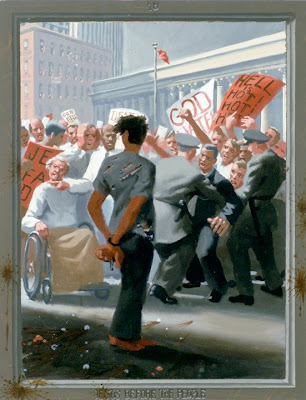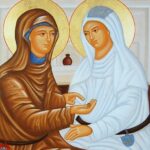Last Updated on April 12, 2025 by Kittredge Cherry
“Behold the man!” — John 19:5 (RSV)
An angry mob confronts a young man in “Jesus Before the People” from “The Passion of Christ: A Gay Vision,” a series of 24 paintings by Douglas Blanchard. Jesus stands alone, handcuffed and motionless in the shadows, before the religious zealots picketing outside the courthouse. He twists his body, turning the other cheek to the crowd that assaults him with insults and rotten eggs. They are enraged, shouting, shaking fists, and waving signs with messages such as “God hates…” The last word is hidden, so the viewer can fill in the blank. This lynch mob could be turning against any disadvantaged group. His head is haloed by a sign demanding “Death to….” Another sign warns, “Hell is hot, hot, hot!” Someone adds an obscene gesture by flipping the finger at Jesus.
 A man in a wheelchair points his index finger sideways, signaling to cut his throat or get the hell out. Police struggle to stop the hostile crowd from killing Jesus right there. He turns his back on the viewer, revealing slashes in his tattered T-shirt. Eggshells, squashed tomatoes, and other debris litter the ground after being hurled at Jesus. Even the frame looks like it is spattered with eggs and gunk in a trompe l’oeil (fool the eye) artistic technique. The only barrier between the mob and the viewer is Jesus.
A man in a wheelchair points his index finger sideways, signaling to cut his throat or get the hell out. Police struggle to stop the hostile crowd from killing Jesus right there. He turns his back on the viewer, revealing slashes in his tattered T-shirt. Eggshells, squashed tomatoes, and other debris litter the ground after being hurled at Jesus. Even the frame looks like it is spattered with eggs and gunk in a trompe l’oeil (fool the eye) artistic technique. The only barrier between the mob and the viewer is Jesus.
The words on the signs suggest that Jesus is a gay man being jeered by fundamentalists. These look like the “God hates fags” signs carried by hate-mongers from Westboro Baptist Church at AIDS funerals and pride marches. “Jesus Before the People” shows the plight of any individual pressured by a group. By scapegoating vulnerable people, bullies maintain power. Blanchard doesn’t dehumanize the demonstrators or resort to demeaning stereotypes. The crowd is multi-racial, but all male, which is realistic for mass street violence.
This painting updates the Biblical episode where Jesus was paraded before the bloodthirsty mob after being whipped. Pilate, the Roman governor, displayed the beaten Jesus to the crowd, exclaiming, “Behold the man!” They responded by shouting, “Crucify him!” The scene is all the more tragic because the crowds adored Jesus less than a week earlier when he entered the city. But the enemies of Jesus managed to stir up enough hate to turn the public against their former hero. In all four gospels Pilate yields to the crowd. He reluctantly sentences Jesus to death, trying to escape responsibility by blaming it on the people. In Matthew’s gospel he literally washes his hands in front of the crowd in a ritual to cleanse himself of guilt. Later interpreters have seen the sympathetic portrayal of Pilate as an attempt to cover up the role of the Roman government in Jesus’ death. The scene has been used to fuel anti-Semitism as Jews were scapegoated as “Christ-killers,” despite the fact that Jesus himself was a Jew, as were his apostles. The crowd in Jerusalem was lashing out at one of their own, erupting in the horizontal violence that often happens among oppressed people, including the LGBT community.
Many artists have painted the scene that is known to art historians by the Latin phrase “Ecce Homo” which is usually translated as “Behold the man.” Like many images from the Passion, the Ecce Homo theme first appeared in art around the 10th century. It was re-enacted in the Passion plays of medieval theater and became popular in the Renaissance, depicted not only in Passion cycles but also on altarpieces and in sculpture groups. Most followed the same pattern, showing Jesus, Pilate, and the unruly crowd in a Jerusalem cityscape. Artists occasionally included self portraits as Christ or members of the crowd. Sometimes they turned the tables on the crowd. Dutch Early Renaissance painter Hieronymus Bosch wreaked revenge on the anti-Jesus faction by turning their faces into ugly caricatures. During the late Renaissance artists began to show Jesus alone in the Ecce Homo scene. They created a new subject called Man of Sorrows that showed a close-up of the anguished face and upper body of Jesus as he was presented to his detractors. Blanchard’s version takes the iconography in the opposite direction, expanding the crowd and turning Jesus away from the viewer.
Modern artists have adapted the Ecce Homo theme to express other forms of human suffering and degradation. German expressionists seemed to have a special affinity for the motif. Otto Dix illustrated the brutality of war in “Ecce Homo with Self Likeness Behind Barbed Wire” and George Grosz satirized human greed, lust, and cruelty with his “Ecce Homo” collection of vignettes from 1920s Berlin. In contemporary times the Latin word homo naturally lends itself to LGBT interpretations. Swedish photographer Elisabeth Ohlson Wallin used it as the name for her famous 1998 photo series recreating the life of Christ with LGBT models. Ecce Homo became a pun meaning both “Behold the man” and “Behold the homosexual.”
___
Next: Day 6A: Jesus is mocked, beaten, goes to his execution and is nailed to the cross
or see the whole series “The Passion of Christ: A Gay Vision.”
The Passion series features 24 paintings by Douglas Blanchard, with text by Kittredge Cherry. It is also available as a book and prints.
Donate now to the 2025 Palm Sunday/Holy Week offering to support this series.
___
To read this article in Italian, go to:
Gesù davati ai sacerdoti, a Pilato e alla folla (gionata.org)
___
Top image credit:
10. Jesus Before the People (from The Passion of Christ: A Gay Vision) by Douglas Blanchard
___
This article was originally published on Q Spirit in April 2017, was expanded with new material over time, and was most recently updated on April 12, 2025.
Scripture quotation is from Revised Standard Version of the Bible, copyright © 1946, 1952, and 1971 National Council of the Churches of Christ in the United States of America. Used by permission. All rights reserved.
Copyright © Kittredge Cherry. All rights reserved.
Qspirit.net presents the Jesus in Love Blog on LGBTQ spirituality.



















You claimed that Jesus only preached love as the only law, but Jesus said bluntly “I have come not to abolish the law but to fulfill it”, and told people to obey the Commandments and other rules such as fasting rules and so forth, so long as they also kept the intent in mind. This article seems to support the idea that the Bible is “whitewashing” the role of the Roman government; but portraying Pilate as a spineless person who caved in to the demands of the mob is certainly not “whitewashing” anything, nor would there be any reason for Pilate to want to crucify Jesus based on his own agenda since the Romans only executed people who led military revolts against themselves or their Judean allies (Judea was a protectorate at that time, not a direct Roman possession until after the First Jewish Revolt was put down by 73 AD). Jesus never encouraged revolt against the Romans, instead saying “Render unto Caesar that which belongs to Caesar”. Trying to spin first-century Judean politics into a modern protest just trivializes and distorts the subject. The article also says “the enemies of Jesus managed to stir up enough hate to turn the public against their former hero” – as if the entire population of Jerusalem suddenly changed their mind. The welcoming crowds a few days earlier were undoubtedly different individuals than the ones who were goaded by the Pharisees to call for Jesus’ crucifixion since Jerusalem was a large city with people of varying opinions, and the Bible itself mentions crowds of Jews arguing against Jesus earlier, not just the Pharisees but also average people.